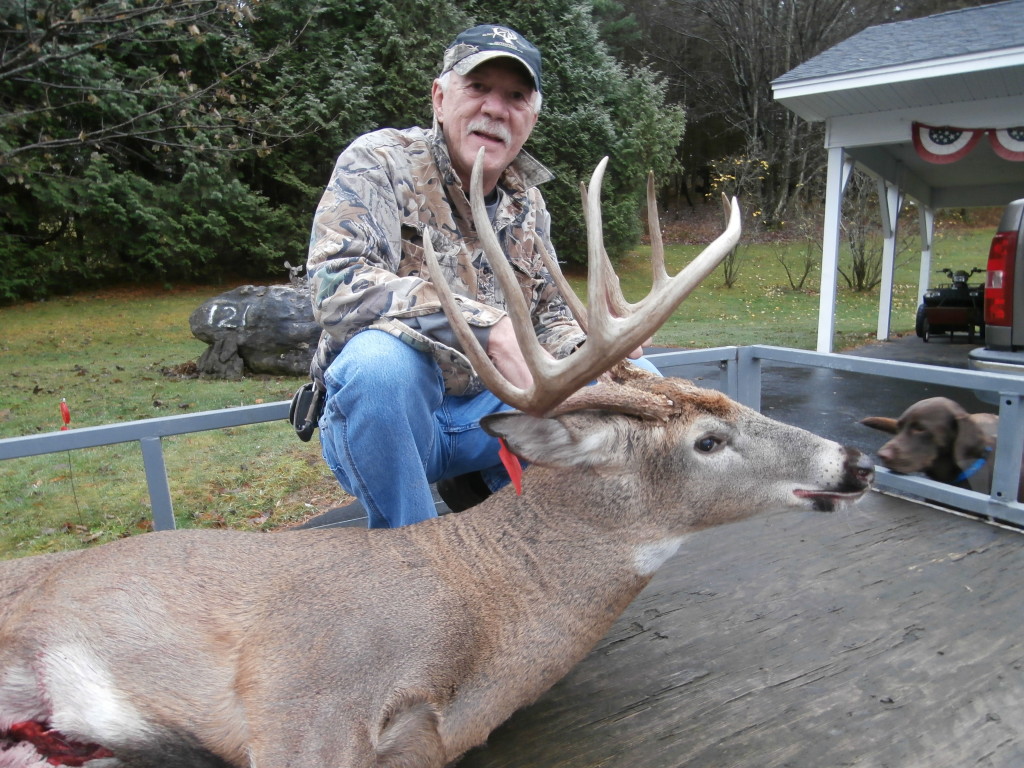The 2015 deer harvest figures have not yet been released by MassWildlife, so today I am switching gears and writing about deer survival during winter.
So far it has been a warm, snowless winter here in the Berkshires and hopefully, our deer and turkey populations are enjoying it. They should be able to have easy access to nuts, apples, browse, etc without having to scrape through feet of frozen hard snow like they had to do last year. Without deep snow, they should be able to flee from predators, too. Perhaps we will have one of those rare open winters or perhaps Mother Nature will make us pay for our current moderate weather later this winter.
When we have a rough winter like we had last year, it is natural for us to pity the poor deer that somehow have to scrounge up food in order to survive. We have a natural inclination to help them out by putting corn, hay or other food out for them. Well, MassWildlife strongly discourages feeding of deer and other wildlife. Supplemental feed sites congregate wildlife into unnaturally high densities, which can:
- Attract predators and increase risk of death by wild predators or domestic pets
- Spread diseases among wildlife or cause other health issues (e.g. Rumen acidosis in deer, Aflatoxicosis in turkeys)
- Cause aggression and competition over food, wasting vital energy reserves and potentially leading to injury or death
- Reduce fat reserves, as wild animals use energy traveling to and from the feeding site
- Cause wildlife to cross roads more frequently, therefore increasing vehicle collisions
- Negatively impact vegetation and habitat in areas where feeding congregates animals.
The most critical time for winter deer survival is March. Deer have a limited supply of fat reserves to carry them through winter. Research has shown that a healthy doe begins winter with a 90-day fat supply. This ticking clock begins winding down in March and is the reason why weather patterns in that month often play the biggest role in deer mortality.
If January and February are brutal but relief comes on time with warming temperatures in March, most deer will sail through with no trouble. If January and February are mild but winter lingers until the end of March, or brutal cold and snow hit late, deer mortality rises.
If you are one of those who simply cannot allow that to happen, the best option is to give them more of the winter foods they are already adapted to eating: winter browse. This includes buds and twigs of woody plants. Introducing new foods in the middle of winter, especially in high quantities all of a sudden, can actually be more harmful to deer than not feeding them at all.
As an example of how deadly it can be, please consider the following: On March 20, 2015, the New Hampshire Fish and Game Department reported that twelve deer were discovered dead in South Hampton, N.H, most likely the victims of well-intentioned, but tragically fatal, supplemental feeding by local residents.
Studies show that a deer has to eat a new food for one to two weeks before it can start pulling in nutrients from that food. This is because it takes time for the micro-flora – the bacteria that live in the deer’s gut and help with digestion – to adjust and become capable of dealing with the new food source. If you haven’t already been providing supplemental feed, don’t introduce it suddenly in large amounts in late winter.
If you can’t supply woody browse, and you feel you have no other option but to provide a new food source, introduce it slowly, in tiny amounts, at multiple sites scattered across the landscape. Give deer time to adjust over a period of two or more weeks before providing unlimited amounts of feed for deer to consume. It comes down to how poor their condition is when they are exposed to the new food and how much of that food they get. The worse shape they are in when they receive the food, the more likely they are to die from it.
If you do provide supplemental feed, provide it at as many locations as possible rather than at one or two sites to avoid creating concentration points where predators, like coyotes, will use to their advantage. Deer are in their poorest condition in March, and they are easier prey for coyotes. In nearby New Hampshire, they often found increased coyote predation around feeding sites. These sites were funneling a lot of deer into a small area and making them easier for coyotes to kill.
If you’re concerned about deer survival in tough winter conditions, the best thing you can do to help them get through the critical last days of March is break out the chainsaw and provide some woody browse. (The bunnies will love you for that, too.) If you grow fruit trees or maybe ornamentals in your yard that require pruning, leave the pruned limbs where deer can reach them
Much of the information used in this article came from MassWildlife, New Hampshire Fish & Game, University of New Hampshire and the Quality Deer Management Association (QDMA), a non-profit conservation organization working to ensure the future of white-tailed deer, wildlife habitat and our hunting heritage. *****
The Berkshire County League of Sportsmen held officer elections recently and the following individuals were returned to office: Mark Jester of Pittsfield – President, Mike Kruszyna, Cheshire – VP, Dan Kruszyna, Cheshire – Treasurer and me as Secretary.
The Taconic Chapter of Trout Unlimited elected the following people: Allen Gray of Pittsfield – President, John Burns, Plainfield – VP, Richard Bordeau, Pittsfield – Treasurer and Paul Knauth, Hinsdale – Secretary.
Happy New Year!

